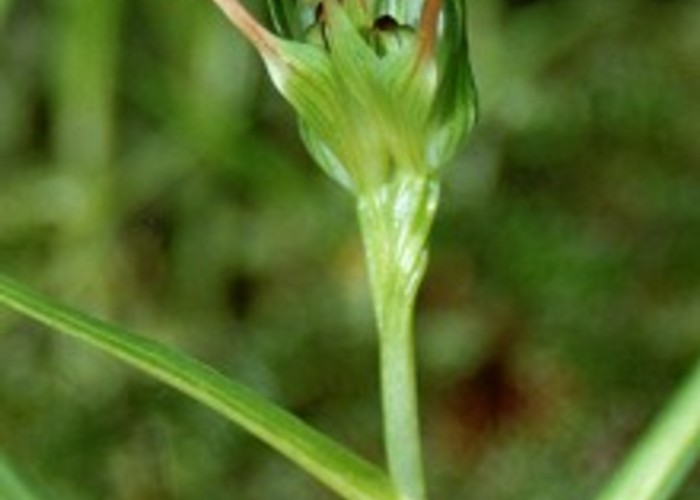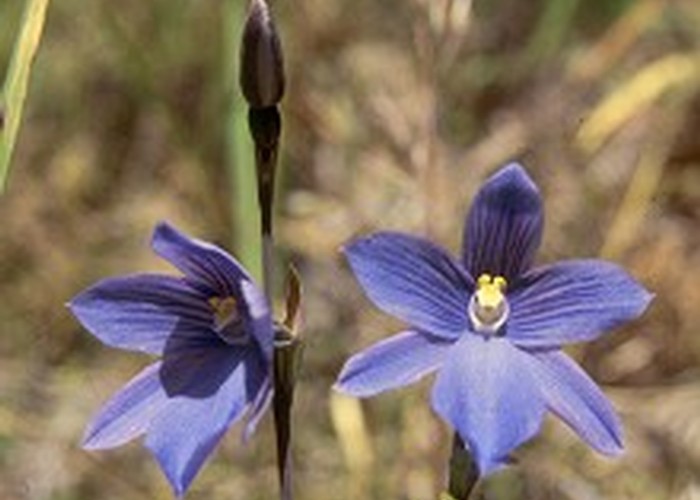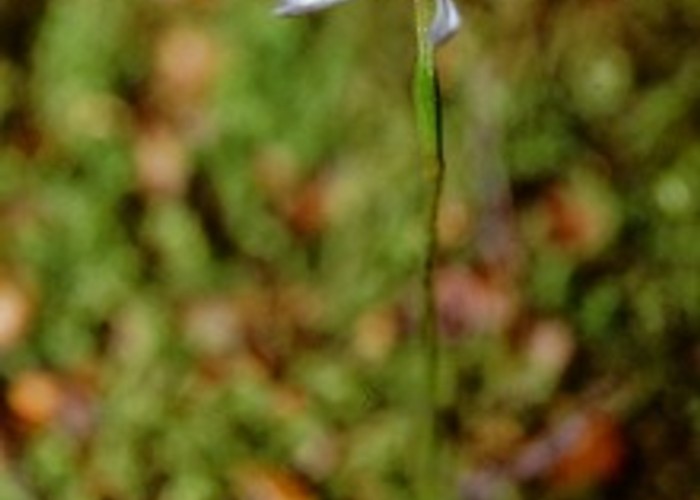Marvels of miniaturisation, they are widespread but commonly unnoticed. Once you start noticing them, however, you'll see them everywhere! The distinctive kidney-shaped leaves of Corybas forming mats on the forest floor . . . The strappy leaves of Thelymitra in roadside clay banks . . . The lime-green spikes of Microtis in roadside grass and urban public gardens . . . The delicate drooping branches of Winika overhead. . . .

It helps to divide New Zealand orchids into two groups: the epiphytes or perching orchids that grow on trees and rocks, and the terrestrial or ground orchids that grow in soil on the forest floor. Here is a brief outline of some of the New Zealand orchids.
Epiphytes
Just seven New Zealand species are epiphytic, often visible as a grassy or ferny bush perched above eye-level on a trunk or on a rock ledge, among ferns and mosses.
- Bulbophyllum pygmaeum
- The tiniest and least "orchid-like" of all, this orchid forms thin mats on tree trunks with matchhead-sized pseudobulbs and a small leaf protruding from the top of each one.
- Earina autumnalis / Easter orchid / raupeka
- Grassy growth with drooping stems and long thin leaves. White, scented flowers in autumn.
- Earina mucronata / bamboo orchid / peka-a-waka
- Grassy growth with drooping, black spotted stems (reminiscent of bamboo) and long, very thin leaves. Yellow and orange flowers in spring.
- Winika cunninghamii / lady's slipper orchid / winika
- Bushy, branching growth with narrow leaves and pretty 20mm pink-and-white flowers. Winika and the Earinas are commonly found in close proximity.
Terrestrials
Terrestrial orchids in New Zealand are annual, maintaining a tuber beneath the leaf litter, and sprouting leaves and flower stems once a year. Many live in the shade of the forest floor, while some are adapted to bogs, clay banks, or sub-alpine herbfields.
- Acianthus sinclairii / pixie cap
- Single stem with a heart-shaped leaf halfway up and greenish red flowers.
- Adenochilus gracilis
- Single stem with a leaf that comes to a point and a white flower with green tints. The dorsal sepal hides the column.
- Chiloglottis cornuta
- The genus is generally indicated by a pair of veined, oval leaves hugging the ground. This species has a green flower with brownish red tints. The peduncle is notably short, although it extends as much as 300mm after flowering, allowing for wide distribution of seed.
- Corybas trilobus / spider orchid
- Corybas is a large genus, but the members are distinguished by their small heart-shaped leaves and pea-sized insectiform flowers with petals and sepals forming long spidery "legs." They often form large colonies. C. trilobus is a common species with a wide, more or less three-lobed leaf.
- Gastrodia cunninghamii / black orchid / huperei
- A saprophytic genus, it associates with soil fungi. Only the flower stems are visible above ground. Warty, dirty yellow flowers are borne on a stem up to 1m tall.
- Microtis unifolia / onion orchid
- A widespread genus, the onion orchids are often found in roadside grasses and other altered environments. They have a single long, rolled, whip-like leaf and a single lime green stalk of flowers up to 1m tall. These flowers are tiny — perhaps 2mm across — and equally green. There are minor differences amongst the several species.
- Prasophyllum colensoi / leek orchid
- A long single stem with rolled leaf like Microtis, but larger flowers striped brown. Often found in montane environments.
- Pterostylis banksii / common greenhood / tutukiwi
- A very large and somewhat confusing genus of which this species is most common. The greenhoods have a single stem with perhaps 6 grassy leaves and topped by a single relatively large hooded green flower. The hood often bears distinctive silver stripes. Lateral sepals form orange antennae-like tails either side of the flower. Other species may produce a basal rosette of leaves as well as or instead of the grassy leaves.
- Thelymitra cyanea
- Another large genus, the sun orchids are often found on clay banks of road cuttings, and in similar exposed situations. They are distinguished by long, strap-like leaves, and a stem of white or blue flowers that only open in full sun. T. cyanea is common in damp ground and has very pretty blue flowers that are large for the genus.
- Thelymitra longifolia / common sun orchid
- Small white or pink flowers with a pink column and a distinctive chocolate brown midlobe. These flowers are rarely fully open.
- Waireia stenopetala yellow beaks / horizontal orchid
- A stout, unpretty orchid of damp alpine and montane herbfields, with yellowish green hooded flowers.

Further Information
- New Zealand Native Orchid Group
The NZNOG is the most comprehensive source of information about New Zealand orchids. The Group publishes a quarterly journal and organises regular field trips. - The Nature Guide to New Zealand Native Orchids by Ian St George. This beautiful publication is a good place to start, with fascinating historic and botanical details, flowering charts and location maps, as well as a colour field guide. It is available from the NZNOG.

